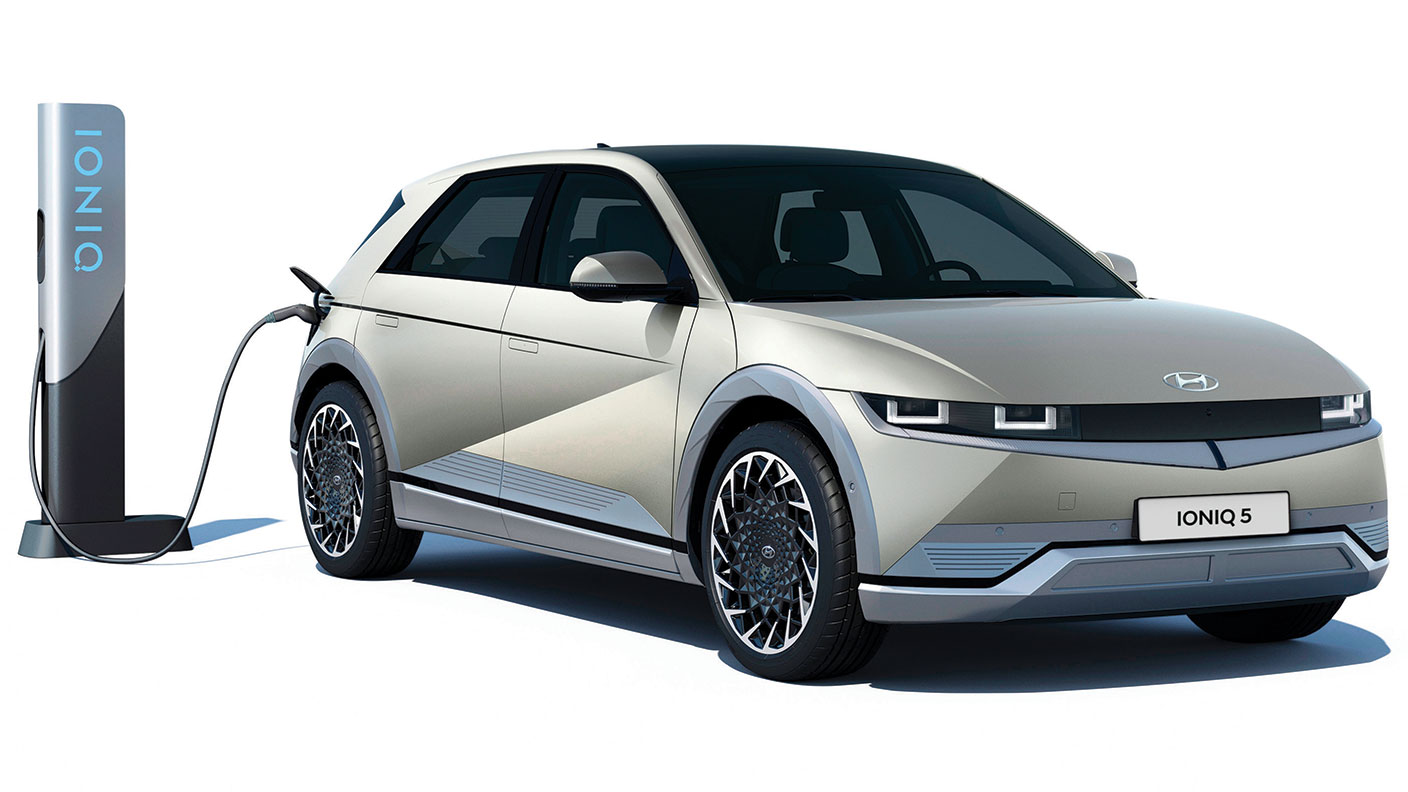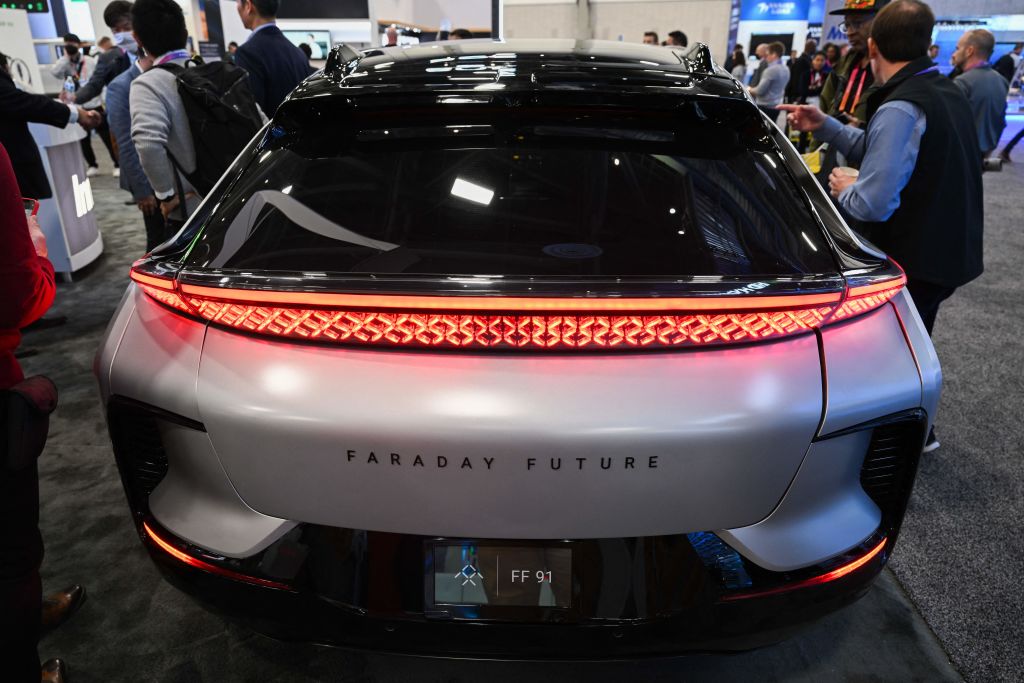How to invest in the electric car market
The vehicle sector suffered badly in the pandemic, and has since been buffeted by supply-chain problems, inflation and recession fears, says David J. Stevenson. But electric cars are thriving.

Car registrations are a key leading indicator. They provide a preview of how the economy will perform in future. In the aftermath of the 2008-2009 financial crisis, world car sales turned into a steadily climbing one-way street. From just over 60 million units in 2009, the global number of passenger vehicles sold grew to around 92 million by 2017, according to the International Energy Agency (IEA). This figure remained unchanged in 2018, however, and declined slightly in 2019 to 88 million.
In 2020, global car sales collapsed to 73 million, says the IEA. Covid-19, along with the resultant government restrictions, caused a speedy and savage recession. It was a very painful period for the world’s car manufacturers.
As normality gradually returned in mid 2021, with fear receding and lockdowns easing, world registrations recovered well. For last year as a whole they were up by roughly 5%, according to data from Statista, despite various supply-chain problems. Indeed, the sales rebound was so strong it outstripped car-manufacturing capacity, which was curbed by a global semiconductor shortage.
MoneyWeek
Subscribe to MoneyWeek today and get your first six magazine issues absolutely FREE

Sign up to Money Morning
Don't miss the latest investment and personal finances news, market analysis, plus money-saving tips with our free twice-daily newsletter
Don't miss the latest investment and personal finances news, market analysis, plus money-saving tips with our free twice-daily newsletter
Most modern cars are equipped with between 300 and 3,000 computer chips that “are crucial to infotainment systems and creature comforts – as well as many of the advanced driver-assistance aids that have become mandatory for five-star safety scores”, notes Joshua Dowling of Drive. As we examine later, inadequate supplies of chips created a damaging car-supply crunch as manufacturers couldn’t meet their production targets, let alone booming demand.
The shortage of new vehicles saw the prices of second-hand cars soar to crazy levels. In the US, the Bureau of Labour Statistics reported that the consumer-price index for both used cars and trucks rose by 41% from January 2021 to January 2022. The average cost of a used American car climbed by about 50%, according to data from car-pricing site Black Book.
Another slowdown
However, global car sales have since broken down once again. From January to May 2022, total registrations of new passenger cars in the EU were 13.7% lower than in the same period the previous year. Sales decreased in Italy by 24.3%, in France by 16.9%, in Spain by 11.5% and in Germany by 9.3%, according to the European Automobile Manufacturers’ Association.
In parallel, June 2022 sales volumes in the US were down by 13.5% from their level of 12 months ago, notes Thomas Feltmate, senior economist at TD Economics. The US has experienced similar difficulties to Europe. Again, the registration decline suggests that a recession could be around the corner, even if the present problems still appear to be caused by supply-chain constraints rather than declining interest from consumers.
Granted, car sales in China – now the world’s largest car market – rose by almost 23% in June from a year earlier as production recovered in lockdown-hit Shanghai to meet pent-up demand. But government cash incentives stimulated purchases, notes the Wall Street Journal. So the data can’t be taken at face value, and a more realistic assessment of China’s car sales can only be made when those incentives expire.
The British position, meanwhile, has been particularly grim. June 2022 new car sales plummeted by a dire 24.3% compared with the same month in 2021. Just 140,958 new cars left showrooms, according to official figures. That made last month the worst June for car sales since 1996. Again, British car showrooms have experienced similar problems to Europe and the US. While demand has held up so far, the semiconductor shortage has continued to bite and inflation concerns have overshadowed the market.
Supply-chain crises
What is really concerning, however, is how carmakers’ problems are now stacking up, partly in ways that weren’t immediately obvious when Russia began its invasion of Ukraine.
Take neon gas. It’s vital to the lasers that are used in manufacturing semiconductors. Prior to Russia’s military activities, Ukraine purified neon that was a “by-product of Russian steel manufacturing” and exported it, says Automotive News.
Indeed, Ukraine probably supplied between 50% and 70% of the world’s neon gas. Now the Russian government has “reportedly restricted the export of noble gases including neon”, says Global Times, in response to the EU’s fifth sanctions round.
So not only have Russian neon exports been curbed, Ukraine’s gas purification capacity has also been compromised by the war. This is causing ongoing restrictions in semiconductor output. While chip makers will eventually secure new neon sources, the process will take time. In other words, the semiconductor supply-chain shortage is set to worsen before it improves.
Another factor creating supply-chain disruption has been China’s zero-tolerance approach to curbing Covid-19. Bottlenecks at Chinese ports are taking a long time to resolve. Labour negotiations at US ports are causing further problems. And global consumer confidence has been hit by the Ukraine conflict, while retail-price inflation has started to soar.
The latter has two main effects. It raises new car prices and it hits buyers’ pockets. So far “carmakers have managed to make up for lost volume by charging higher prices, though it’s unclear how much higher they can go”, says Bloomberg. Meanwhile, the rising cost of living is eroding consumers’ real (inflation-adjusted) incomes. In other words, they have less cash to splash on new vehicles.
Having cut its forecast for Western European passenger car sales in each of the past four months, industry analyst LMC Automotive now expects annual deliveries to dip by 6% this year to less than ten million units. That’s a massive downgrade from its forecast in January, when LMC was expecting nearly 9% growth.
Global vehicle sales will shrink by 5% in 2022, Germany’s Centre for Automotive Research (CAR) told Neil Winton in Forbes. “The global car market will have thus fallen below the level of the first Corona year 2020 and will reach its lowest level in ten years,” says CAR director Ferdinand Dudenhoeffer.
The one bright spot
Yet there is one bright spot amid the gloom. Sales of zero-carbon, battery electric vehicles (BEVs) are booming – though this doesn’t apply to ‘hybrids’, which have internal combustion engines as well as electric motors, whose sales are struggling.
In the US, BEV sales increased by 60% year on year to 158,689 in the first quarter of 2022, according to car registration data from Experian, reaching a new record market share of 4.6%.
Among the top ten all-electric cars in the US, four were Tesla models and three were from Hyundai, according to trade magazine InsideEVs – including the Korean carmaker’s Ioniq 5.
The only other cars in the top ten were the Ford Mustang Mach-E, the Nissan LEAF and the Volkswagen ID.4 (pictured right). Hyundai sold 15,414 units, including 8,450 cars under the Kia badge (one-third owned by Hyundai) and 6,964 vehicles under its own name. The company’s total sales in the period were twice those of Ford.
UK BEV registrations in June 2022 were 22,737, up 15% year on year, says sales company heycar. This means there are now an estimated 477,000 electric cars on the road in Britain. Their market share has reached 16.1%, up from 10.7% in 2021.
So the future for all-electric cars is looking even more promising than before, says the IEA. “Despite strains along global supply chains, sales kept rising strongly into 2022”, it notes, “with two million electric cars sold worldwide in the first quarter, up by three-quarters from the same period a year earlier”.
Certainly, soaring prices of key materials for making batteries – essential for all electric cars – are a concern. Russia provides 20% of global battery-grade nickel, so there are supply worries following it sinvasion of Ukraine. Meanwhile China has a stranglehold over lithium-ion battery manufacture: it has 70% of the production capacity for cathodes and 85% for anodes, again both vital components.
Other impediments, such as the UK cutting its electric-car grant scheme a year earlier than expected – may appear. But the IEA also notes that “a growing number of countries have ambitious vehicle electrification targets for the coming decades, and many carmakers have plans to electrify their fleets that go beyond policy targets”.
“Move over, gasoline-powered cars,” say Lisa Martine Jenkins in Protocol. “More electric vehicles are set to take the road, and adoption might be even faster than previous analyses have forecast.
“Just one year ago, the consultancy BCG projected that battery-electric vehicles would make up 11% of global new light vehicle sales in 2025 and 45% in 2035. Now, the group’s latest analysis found that battery-powered EVs will amount to 20% of global sales by 2025 and 59% in 2035. They are projected to be the most popular type of light vehicle sold by 2028, three years earlier than they found in 2021.”
The best electric-car makers to buy
History shows that car manufacturing is not a particularly appealing area for investors. Researching and developing new vehicles is very expensive.
This means that vehicle makers are very capital-intensive and can suffer significant balance-sheet strains. What’s more, the business can be highly cyclical. Vehicle makers may find that their very expensive product launches coincide with recessions that crush sales just when these car companies need a strong tailwind.
Looking for suitable investments in the sector, therefore, can prove difficult. Chinese electric vehicle maker BYD has a stratospheric valuation. Meanwhile Tesla is the clear choice from the above list of popular all-electric cars in the US. But despite dropping by 40% from their November 2021 peak, the shares still look very expensive.
Tesla has a current market capitalisation of $760bn. Yet it only delivered just over a quarter of a million vehicles in this year’s second quarter. Japanese giant Toyota, by contrast, has a market value of $214bn and sold 514,100 vehicles in the US alone over the same three-month period – despite having to recall more than 2,000 all-electric SUVs over problems that could cause the wheels or axles to fall off.
Even as far out as 2024, Tesla stands on a forecast price/earnings (p/e) ratio of a whopping 39, according to the average of analysts’ estimates compiled by MarketWatch. And this assumes a near 75% jump in earnings over the next two years, which seems doubtful as the US economy teeters on the brink of recession.
Hyundai (LSE: HYUD) is the next most popular maker of all-electric cars in the US, even though BEVs currently account for just 5% of total sales. In sharp contrast to Tesla, however, Hyundai’s shares still look very cheap.
You can buy into the company via its GDR (global depository receipt): each represents half an ordinary share. Net debt is high at 90% of shareholders’ funds. However the shares stand on a forward p/e of a mere 4.2, according to analysts’ forecasts compiled by Barron’s, and yield 6.2%.
While carmakers tend to sell on below-average p/es, by all measures Hyundai is on a very low valuation. After declining by more than a third over the past eight years, this stock looks like one to tuck away.
Meanwhile, despite all-electric vehicle sales accounting for only 5.2% of total 2022 first-quarter turnover, German carmaker Volkswagen (Frankfurt: VOW) is optimistic about the prospects for BEVs.
While semiconductors still represent a supply bottleneck, this is likely to change soon, VW CEO Herbert Diess told CNBC. “We will see an alleviation through the next weeks... we are ramping up production… five assembly plants are coming into production now.”
So delivery times for EVs should shorten as the year progresses. “The outlook is very good, we have [a] very good order intake in Asia,” continues Deiss. “There’s high demand in Europe and also in the US.”
By 2030 VW says that it is aiming to derive at least 70% of its European revenue from electric cars. In China and North America, the company’s goal is to generate at least 50% of turnover from BEVs.
Down by 45% from their April 2021 highs, VW shares currently sell on a prospective p/e of just 5.5, according to the average of analysts’ estimates compiled by MarketWatch. Further, the historic dividend yield is 5.5%.
Admittedly, net debt is higher than equity and there’s a risk that the pay-out to shareholders may be trimmed this year. But VW is a cheap share that could benefit from a long-run re-rating as its all-electric vehicle sales increase.
Get the latest financial news, insights and expert analysis from our award-winning MoneyWeek team, to help you understand what really matters when it comes to your finances.
David J. Stevenson has a long history of investment analysis, becoming a UK fund manager for Oppenheimer UK back in 1983.
Switching his focus across the English Channel in 1986, he managed European funds over many years for Hill Samuel, Cigna UK and Lloyds Bank subsidiary IAI International.
Sandwiched within those roles was a three-year spell as Head of Research at stockbroker BNP Securities.
David became Associate Editor of MoneyWeek in 2008. In 2012, he took over the reins at The Fleet Street Letter, the UK’s longest-running investment bulletin. And in 2015 he became Investment Director of the Strategic Intelligence UK newsletter.
Eschewing retirement prospects, he once again contributes regularly to MoneyWeek.
Having lived through several stock market booms and busts, David is always alert for financial markets’ capacity to spring ‘surprises’.
Investment style-wise, he prefers value stocks to growth companies and is a confirmed contrarian thinker.
-
 Investors will reap long-term rewards from UK equities
Investors will reap long-term rewards from UK equitiesOpinion Nick Train, portfolio manager, Finsbury Growth & Income Trust, highlights three UK equities where he’d put his money
-
 The graphene revolution is progressing slowly but surely
The graphene revolution is progressing slowly but surelyEnthusiasts thought the discovery that graphene, a form of carbon, could be extracted from graphite would change the world. They might've been early, not wrong.
-
 8 of the best houses for sale with electric vehicle charging
8 of the best houses for sale with electric vehicle chargingThe best houses for sale with electric vehicle charging – from a converted World War II control tower in Scotland, to a Victorian country house in Cumbria
-
 The Stella Show is still on the road – can Stella Li keep it that way?
The Stella Show is still on the road – can Stella Li keep it that way?Stella Li is the globe-trotting ambassador for Chinese electric-car company BYD, which has grown into a world leader. Can she keep the motor running?
-
 'EV maker Faraday Future will crash'
'EV maker Faraday Future will crash'Faraday Future Intelligent Electric is failing dismally to live up to its name, says Matthew Partridge
-
 Halifax: House price slump continues as prices slide for the sixth consecutive month
Halifax: House price slump continues as prices slide for the sixth consecutive monthUK house prices fell again in September as buyers returned, but the slowdown was not as fast as anticipated, latest Halifax data shows. Where are house prices falling the most?
-
 Rents hit a record high - but is the opportunity for buy-to-let investors still strong?
Rents hit a record high - but is the opportunity for buy-to-let investors still strong?UK rent prices have hit a record high with the average hitting over £1,200 a month says Rightmove. Are there still opportunities in buy-to-let?
-
 Pension savers turn to gold investments
Pension savers turn to gold investmentsInvestors are racing to buy gold to protect their pensions from a stock market correction and high inflation, experts say
-
 Where to find the best returns from student accommodation
Where to find the best returns from student accommodationStudent accommodation can be a lucrative investment if you know where to look.
-
 The world’s best bargain stocks
The world’s best bargain stocksSearching for bargain stocks with Alec Cutler of the Orbis Global Balanced Fund, who tells Andrew Van Sickle which sectors are being overlooked.